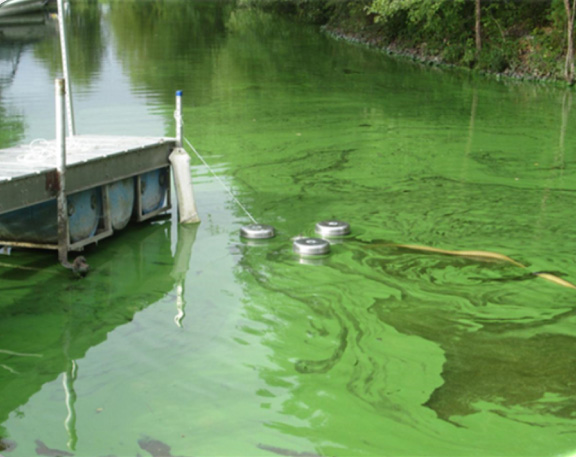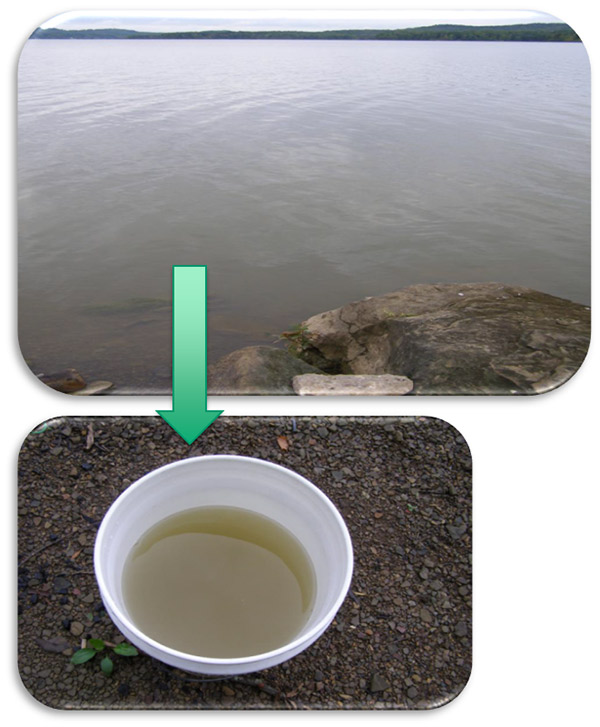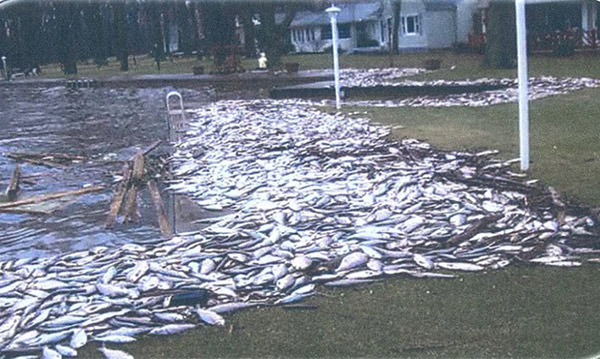Harmful Algal Blooms & Water Quality
(Updated August, 2021)
Harmful Algal Blooms (HABs) are a real problem for source water managers. Understanding what this problem is, being aware of when the problem exists, and then being able to act on the problem before it is unmanageable is critical to the health of our water bodies.
What is a Harmful Algal Bloom?
Let’s work backwards on the phrase “Harmful Algal Bloom” to better understand it. The term “bloom” refers to an overgrowth of algae, and “bloom” is quite fitting because the burst of growth can occur very rapidly. Blooms can look very different from site to site, and at a given site the appearance of a bloom can even change throughout the course of the day, as algae grow and die, or as they vertically migrate through the water column. Often when people think of a HAB they think of the “scum formers,” like Microcystis aeruginosa (Figure 1). Blooms like these are quite typical of what we see in freshwater sites across the U.S., and they can be the consequence of Microcystis or other organisms, even mixed together.

Figure 1, photo courtesy of Beagle Bioproducts, Inc.
We are starting to see more blooms, however, like the Cylindrospermopsis bloom (Figure 2), which can just look like muddy water but in fact, is a fairly rich growth. Blooms of Planktothrix can sometimes look like this because it distributes itself in the water column. It is planktonic, hence its name.

Figure 2, photo courtesy of the Ohio EPA
In both cases (Figures 1 and 2), while appearing very different, these blooms are toxic, they can lead to issues in drinking water, and they can be very hard to detect before the bloom is beyond management.
Returning to the phrase “Harmful Algal Bloom,” let’s talk about what algae are. In the context of HABs, the term “algae” refers to a very broad range of organisms, but especially to dinoflagellates, diatoms, and cyanobacteria. Cyanobacteria are the most relevant to our discussion of freshwater HABs, and you may also know them by the name “blue-green algae.”
A challenge with cyanobacterial blooms is that they can look very much like Figure 1, but that doesn’t necessarily mean they are being caused by a toxin-producing cyanobacterium. For example, an algal bloom dominated by the cyanobacterium Oscillatoria can look very similar to the bloom of Microcystis shown in Figure 1, but under the microscope the filament-like cellular morphology of Oscillatoria is easily distinguished from the microcolonies of Microcystis. The organisms differ in other important ways, too.
For example, Oscillatoria is able to fix nitrogen to supplement its growth in nitrogen-depleted environments. Microcystis cannot fix nitrogen, so nitrogen must be present in high concentrations to support bloom levels of growth.
Thus, knowing which of these two cyanobacteria might be present could be a clue as to the type of nutrients that might be feeding the bloom. With either nitrogen fixers or non-nitrogen fixers, the other key nutrient that becomes available to the algae in these situations is phosphorus. But the most concerning difference between an Oscillatoria bloom and one dominated by Microcystis is that the latter is a notorious toxin producer, and the toxins can be harmful to animals, including humans.
In fact, the "Harmful" in “Harmful Algal Bloom” primarily refers to the production of toxins, and sometimes people refer to “toxic algal blooms” rather than “harmful algal blooms.” The toxin microcystin, first identified from Microcystis, is the most widespread, and it is known to cause liver cancer in animals and is presumed to be able to do so in humans, with chronic exposure. It can be an acute, life-threatening poison for livestock and wildlife, though, and as shown in the Table here microcystin is now known to be produced by more organisms than just Microcystis (note that this may not be a complete list!). Anatoxin-a and cylindrospermopsin are other toxins that are monitored in many states and countries. There are dozens of algal toxins, but these three are the most common concern in freshwater HABs in the U.S.
 While harmful is usually synonymous with toxin, there are other harmful effects of HABs. One of the most dreadful is a fish kill, such as the one shown in Figure 3 from 2011 at Grand Lake-St. Mary’s Lake in Celina, OH. This scenario used to be rare but plays out at multiple lakes in the U.S. every year now. It’s interesting to note that in this case and most other freshwater HABs, the toxins are not what kills the fish. Rather, it is anoxic conditions that are created as a consequence of the bloom. As the bloom starts to die off, the dead algae sink to the bottom of the lake, where they are degraded as food by heterotrophic bacteria. That degradation process consumes oxygen, and there is so much dead algae biomass to degrade that eventually the oxygen is depleted. These fish effectively suffocated, then, due to the depleted oxygen in the water.
While harmful is usually synonymous with toxin, there are other harmful effects of HABs. One of the most dreadful is a fish kill, such as the one shown in Figure 3 from 2011 at Grand Lake-St. Mary’s Lake in Celina, OH. This scenario used to be rare but plays out at multiple lakes in the U.S. every year now. It’s interesting to note that in this case and most other freshwater HABs, the toxins are not what kills the fish. Rather, it is anoxic conditions that are created as a consequence of the bloom. As the bloom starts to die off, the dead algae sink to the bottom of the lake, where they are degraded as food by heterotrophic bacteria. That degradation process consumes oxygen, and there is so much dead algae biomass to degrade that eventually the oxygen is depleted. These fish effectively suffocated, then, due to the depleted oxygen in the water.
Other harmful consequences of a bloom might include taste and odor compounds, like the small volatile molecules geosmin and MIB. These compounds are not toxic at the levels where humans initially detect them, since that is in the ng/L range, but they can certainly cause headaches for source water managers because of unhappy drinking water customers complaining that the water smells or tastes like dirt.
If the water source is also used recreationally or is in an area of commerce, there can be economic impacts due to the appearance and smell, especially during the late stages of a bloom as they die and rot.
Finally, as biomass accumulation outpaces heterotrophic degradation at the bottom of the lake or reservoir, dredging may become necessary. The consequences, then, of a HAB can be very severe for source water managers, and the big push in dealing with them is to be proactive, rather than reactive, heading off some of the harmful effects before they get out of hand.
What Should One Monitor?
While prevention is always the best medicine, surface water managers don’t always have control over their watersheds in a way that would prevent nutrient runoff that feeds HABs, and of course none of us can control meteorological or other environmental conditions that also contribute to HABs. A good strategy can be based upon early detection, and having treatment and mitigation strategies lined up to react to the results of your monitoring efforts. So for early detection of HABs, here are recommendations on what should be monitored, and why. (Learn more, Answers to the Top 5 HAB Monitoring Questions).
The pigments phycocyanin and chlorophyll are imperative for a HAB monitoring strategy. Chlorophyll is found in almost all algae, and of course in plants, too. Phycocyanin is a more specific indicator of blue-green algae; it’s the “blue” part of the name. Chlorophyll has been used for decades to monitor the growth of algae in aquatic systems, usually by collecting a grab sample and taking it to a laboratory for analysis. Phycocyanin has been added to monitoring strategies more recently as new technologies have become available. Both pigments can now be detected in situ using highly sensitive sensors, saving valuable time related to laboratory analyses of pigments. Baselines need to be established for the pigments in the off-season, and then deviations from those baselines can be an early warning signal that cyanobacteria are on the rise in a system. Also, just because phycocyanin is present doesn’t mean that a toxic bloom is imminent (recall the non-toxic Oscillatoria bloom from earlier in our conversation), but if there is NO phycocyanin, it is less likely that there are potentially toxic blue-green algae present.
The toxins themselves are always worth monitoring, especially in drinking water reservoirs and surface waters used for recreation. It can be expensive to do so, however, and toxin analysis requires a lab and trained personnel. From a management perspective, then, it may be more feasible to measure the toxins (e.g. microcystin, cylindrospermopsin, anatoxin-a, etc.) when the pigment monitoring suggests the potential for blue-green algae to be on the rise.
Less expensive long-term monitoring parameters that can provide clues to the potential for HAB to develop include standard water quality parameters that a lot of managers may already be looking at. Temperature is useful because some of the most notorious cyanobacteria, like Microcystis aeruginosa mentioned above, favor water temperature above 30 degrees Celsius (86 Fahrenheit), and grow so fast at those temperatures that they overtake a system rapidly. This is one reason HABs occur more frequently in the summer months in temperate climates.
 Dissolved oxygen and pH are very relevant as well. As the algae grow, the pH can rise rapidly—as high as 10 or even 11. This is one of the hallmark properties of a HAB and is related to the consumption of dissolved carbon dioxide by the algae. Dissolved oxygen will decline, especially in the latter stages of a bloom, as it is consumed somewhat by the blooming algae, but especially as it is consumed by heterotrophic bacteria that degrade algal corpses that sink to the bottom of the water body. As mentioned already this is a major cause of fish kills in freshwater systems, as the fish are deprived of oxygen. Conductivity can also be monitored in a continuous fashion and is useful because lower conductivity, such as is characteristic of freshwater systems, is favorable to blue-green algae growth.
Dissolved oxygen and pH are very relevant as well. As the algae grow, the pH can rise rapidly—as high as 10 or even 11. This is one of the hallmark properties of a HAB and is related to the consumption of dissolved carbon dioxide by the algae. Dissolved oxygen will decline, especially in the latter stages of a bloom, as it is consumed somewhat by the blooming algae, but especially as it is consumed by heterotrophic bacteria that degrade algal corpses that sink to the bottom of the water body. As mentioned already this is a major cause of fish kills in freshwater systems, as the fish are deprived of oxygen. Conductivity can also be monitored in a continuous fashion and is useful because lower conductivity, such as is characteristic of freshwater systems, is favorable to blue-green algae growth.
Turbidity can be a surrogate measurement for increases in blue-green algae populations, and also is a good indicator of runoff events that can introduce nutrients that will feed algae. Some managers actually partner with a laboratory to measure the nutrients directly: ammonium, nitrate, total nitrogen, and total phosphorus can all be useful parameters, as they can stimulate the growth of potentially toxic blue-green algae.
In Conclusion
So, it is pretty obvious by now, we are talking about collecting a lot of data. There aren’t specific numbers that mean “bloom” or “no bloom,” and what one must aim for is gaining an understanding of your site over the long term, so that specific patterns will emerge that are meaningful. The first year of monitoring is very important because that’s where baselines are established. Then year after year, a deeper understanding of the site is developed, and which patterns are meaningful. In this manner, managers can proactively detect the possible onset of a bloom, at a time when it is far easier to respond than when the bloom is in full force and has overtaken a system.
Responses can take a variety of forms, and entire manuals are available for drinking water managers and others. I hope you find these monitoring recommendations useful for your water sources that might be affected by HABs, and that such monitoring can form the basis for an effective, data-driven management strategy.
Watch the Webinar: Solve a Major Water Quality Issue | Harmful Algal Blooms
View the SlideShare slide deck from a presentation Dr. Smith gave at the American Water Resource Association meeting.

Additional Blog Posts of Interest:
The Latest in HAB Research and Technology
How Algae Sensors Work | Answers to Four Challenging Questions
The Basics of Chlorophyll Measurement in Surface Water
Safeguarding Source Water: How Online Monitoring of Algae Leads to Data-Driven Decisions [Webinar]